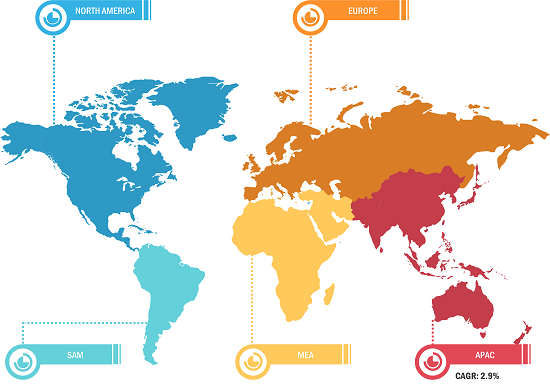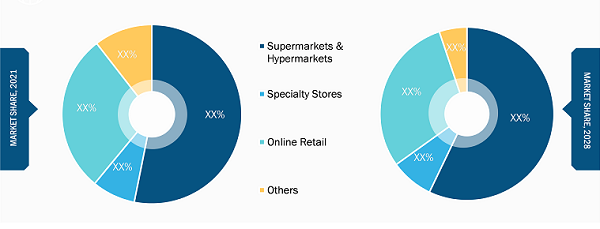Der Meeresfrüchtemarkt wird voraussichtlich von 1.71.493,93 Millionen US-Dollar im Jahr 2022 auf US-Dollar wachsen 2.01.253,49 Millionen bis 2031; Von 2022 bis 2031 wird ein durchschnittliches jährliches Wachstum von 3,0 % erwartet.
Die Food and Drug Administration (FDA) gab an, dass Meeresfrüchte alle kommerziell gewonnenen Salzwasser- und Süßwasserfische, Weichtiere und Krebstiere umfassen. Es wird erwartet, dass die Nachfrage nach Meeresfrüchten aufgrund ihrer gesundheitlichen Vorteile weltweit dramatisch zunehmen wird. Nach Angaben der Ernährungs- und Landwirtschaftsorganisation (FAO) wird bis 2030 ein zusätzlicher Wert von 40 Millionen Tonnen Meeresfrüchten erforderlich sein, was einer Steigerung von ca. 30 % entspricht, um die steigende Nachfrage in den kommenden Jahren zu decken. Darüber hinaus wird erwartet, dass der steigende Pro-Kopf-Verbrauch, begleitet von der Nachfrage des wohlhabenden Landes nach importierten Meeresfrüchteprodukten, das Marktwachstum im Prognosezeitraum unterstützen wird.
Asien-Pazifik hielt den größten Anteil am Meeresfrüchtemarkt im Jahr 2021. Länder wie Japan, China und Südkorea haben in ihren Kulturen eine traditionelle Bedeutung von Fisch; Daher dürfte die hohe Nachfrage nach Fisch in diesen Ländern das Wachstum der Meeresfrüchteindustrie ankurbeln. Neben frischen Meeresfrüchten erfreuen sich auch Meeresfrüchte in Dosen großer Beliebtheit bei der Bevölkerung der Region. Beispielsweise ist Thunfisch bei Asiaten aufgrund seines ansprechenden Geschmacks und seiner Fähigkeit, sich gut mit verschiedenen Geschmacksrichtungen zu kombinieren, sehr beliebt. Thunfischkonserven weisen im Vergleich zu herkömmlichen Thunfischprodukten, die auf dem APAC-Markt Einzug halten, einen einzigartigen Geschmack auf. Darüber hinaus treibt das verbesserte Vertriebssystem mit den wachsenden E-Commerce-Diensten das Wachstum des Fischmarktes voran.
Strategische Einblicke
Aufschlüsselung des Meeresfrüchtemarktes – nach Region

Markteinblicke
Erhöhte Nachfrage nach gefrorenen und konservierten Meeresfrüchten
Aufgrund der steigenden Nachfrage nach verarbeiteten Meeresfrüchten wächst der Markt für gefrorene und konservierte Meeresfrüchteprodukte weltweit rasant. Gefrorene Meeresfrüchteprodukte werden gefrierverarbeitet, was dazu beiträgt, die Bakterienbildung in Lebensmitteln zu verhindern und ihre Haltbarkeit zu verlängern. Ebenso wird Fischkonserven in einem verschlossenen, luftdichten Behälter wie einer Aluminium- oder Blechdose verarbeitet und aufbewahrt. Fischkonserven sind in der Regel 1–5 Jahre haltbar. Aufgrund der steigenden Nachfrage nach Fertiggerichten erfreuen sich Meeresfrüchtekonserven bei den Verbrauchern großer Beliebtheit. Auch gefrorene Meeresfrüchte wird von den Verbrauchern positiv aufgenommen und ist ein Vorreiter das Marktwachstum. Durch die Einführung neuer Technologien behalten gefrorene Meeresfrüchte ihren Nährwert und schmecken ähnlich wie frische Meeresfrüchte. Durch das Einfrieren wird der Verwesungsprozess verlangsamt, wodurch der Nährwert erhalten bleibt. Wenige Stunden nach dem Fang eingefrorener Fisch enthält gut erhaltene Vitamine. Es wurde festgestellt, dass frischer Fisch einem schnellen Verfall unterliegt und eine kürzere Haltbarkeitsdauer hat. Daher treiben der steigende Bedarf an Bequemlichkeit und längerer Haltbarkeit von konservierten und gefrorenen Meeresfrüchteprodukten in Verbindung mit zunehmenden Forschungs- und Entwicklungsaktivitäten der Hauptakteure das Wachstum des Meeresfrüchtemarktes auf der ganzen Welt voran.
Produkttypbasierte Einblicke
< p>Basierend auf dem Produkttyp ist der Meeresfrüchtemarkt in Fische, Krebstiere, Weichtiere und andere unterteilt. Das Segment Krebstiere wird im Prognosezeitraum voraussichtlich die höchste CAGR verzeichnen. Krebstiere gehören zum Unterstamm Crustacea (Stamm Arthropoda), einer Gruppe wirbelloser Tiere, die weltweit etwa 45.000 Arten umfasst. Zur Gruppe der Krebstiere gehören einige häufig verzehrte Meeresfrüchte wie Krabben, Garnelen, Hummer, Garnelen, Flusskrebse, Krill und Seepocken. Sie helfen bei der Gewichtsabnahme, stärken das Immunsystem und fördern Hitze und Hitze. Gehirngesundheit. Curry-Krabben & Knödel, Hummer Newburg, Topfgarnelen, Moeche, Garnelenbiskuit, Getreidegarnelen und Krabbensuppen sind einige der berühmtesten Gerichte, die mit Krustentieren zubereitet werden und auf der ganzen Welt verzehrt werden.Einblicke in die Vertriebskanäle
Basierend auf der Verbreitung ist der Markt für Meeresfrüchte in Supermärkte und Verbrauchermärkte, Fachgeschäfte, Online-Einzelhandel und andere unterteilt. Die Supermärkte & Das Segment der Verbrauchermärkte hatte im Jahr 2021 den größten Anteil am Markt für Meeresfrüchte. Unter Supermärkten und Verbrauchermärkten versteht man Selbsthilfeläden, die eine große Auswahl an Produkten zum Verkauf anbieten. Meeresfrüchte haben in Supermärkten und Verbrauchermärkten eine eigene Abteilung. Somit steht den Kunden vor allem im Tiefkühlbereich eine große Auswahl an Optionen zur Verfügung. Die Fischtheken in Supermärkten und Verbrauchermärkten gelten als ausgezeichnete Orte, um eine große Auswahl an frischen und gefrorenen Meeresfrüchten zu kaufen. Es wird erwartet, dass diese Faktoren das Wachstum des Segments vorantreiben.
Meeresfrüchtemarkt, nach Vertriebskanal – 2022 und 2031 < /strong>
< /strong>
Einige der wichtigsten Akteure auf dem Fischmarkt sind American Seafoods Company LLC, Kangamiut Seafood A/C, Lee Fishing Company, Pacific American Fish Co. Inc., Royal Greenland A/S, Mowi ASA, The Union Group PCL, Grupo Nueva Pescanova, Trident Seafoods Corporation und SeaPak Shrimp &Ampere; Meeresfrüchte-Unternehmen. Diese Akteure beschäftigen sich mit der Entwicklung von Produkten mit geringeren Gesundheitsrisiken, um aufkommende Verbrauchertrends zu erfüllen und regulatorische Rahmenbedingungen einzuhalten. Sie sind an Fusionen und Übernahmen, Geschäftserweiterungen und Partnerschaften beteiligt, um ihren Marktanteil auszubauen.
Report Spotlights
- Progressive Branchentrends im Fischmarkt, um Spielern bei der Entwicklung effektiver langfristiger Strategien zu helfen
- Unternehmenswachstumsstrategien angenommen Sicheres Wachstum in entwickelten und sich entwickelnden Märkten
- Quantitative Analyse des Meeresfrüchtemarktes von 2022 bis 2031
-
よくある質問
1Can you list some of the major players operating in the global seafood market?The major players operating in the global seafood market are American Seafoods Company LLC, Kangamiut Seafood A/C, Lee Fishing Company, Pacific American Fish Co. Inc., Royal Greenland A/S, Mowi ASA, The Union Group PCL, Grupo Nueva Pescanova, Trident Seafoods Corporation, SeaPak Shrimp & Seafood Company among many others.2Which region held the largest share of the global seafood market?In 2019, the Asia Pacific held the largest share of the global seafood market. Asia Pacific is a mature and well-established market for seafood. Countries such as Japan, China, and South Korea have a traditional significance of fish in their cultures, and hence, the high demand for fish in these countries is likely to fuel the growth of the seafood market. In addition to fresh seafood, canned seafood is also highly embraced by the region’s population. For instance, tuna is highly popular among the Asian people attributed to its appealing taste and ability to blend well with multiple flavors. The canned tuna products penetrating the Asian market are exhibiting unique flavors apart from the conventional ones. However, in recent years the canned tuna sales in the region have been declining due to the consumers swaying towards other seafood, particularly shellfish. Thus, the manufacturers have been innovating their products in terms of base ingredients that can attract consumers. However, in Australia, canned tuna sales are escalating.-->3Based on type, why is the crustaceans type segment expected to grow at the highest rate during 2020–2027?The growth of the crustaceans type segment is primarily attributed to the fact as many species of crustaceans are found in freshwater, seawater and also in inland brines. The crustaceans group include some commonly consumed seafoods like crab, shrimp, lobsters, prawns, crayfish, krill and barnacles. These crustaceans develop form larvae and bear segmented, split limbs or appendages. The fisheries in many parts of the world capture prawns, shrimps, spiny lobsters and king crabs, especially from the Northern Pacific and its southern counterparts. Many species of true crabs like the blue crab, Dungeness crab and stone crab serves as a valuable source of food. Crustaceans are consumed as seafoods as they are loaded with lean proteins, micronutrients and healthy fats. They aid in weight loss, helps in boosting immunity and promotes heat & brain health.- Historische Analyse (2 Jahre), Basisjahr, Prognose (7 Jahre) mit CAGR
- PEST- und SWOT-Analyse
- Marktgröße Wert/Volumen – Global, Regional, Land
- Branchen- und Wettbewerbslandschaft
- Excel-Datensatz
Aktuelle Berichte
Verwandte Berichte
Soja-Lebensmittelmarkt Markt für veganes Trockenfutter für Haustiere Reptilienfuttermarkt Markt für selbsterhitzende Lebensmittelverpackungen Markt für Meeresfrüchtepulver Markt für Superfood-Pulver Markt für Meeresfrüchte-Snacks Markt für Schlankheitsnahrungszutaten Veganer Fast-Food-Markt Markt für Hydrokolloide aus Meeresalgen Sportnahrungsmarkt Nachhaltiger Fischmarkt Puffed Food Markt Markt für Meeresfrüchteextrakte Markt für verschreibungspflichtige medizinische Lebensmittel Markt für veganes Nassfutter für Haustiere Fischmarkt Veganer Lebensmittelmarkt RTC-Lebensmittelmarkt Markt für verzehrfertige LebensmittelErfahrungsberichte
Grund zum Kauf
- Fundierte Entscheidungsfindung
- Marktdynamik verstehen
- Wettbewerbsanalyse
- Kundeneinblicke
- Marktprognosen
- Risikominimierung
- Strategische Planung
- Investitionsbegründung
- Identifizierung neuer Märkte
- Verbesserung von Marketingstrategien
- Steigerung der Betriebseffizienz
- Anpassung an regulatorische Trends




















 Kostenlose Probe anfordern für - Fischmarkt
Kostenlose Probe anfordern für - Fischmarkt